Domestic sewer pumping stations: types, design, installation examples
The topic of sewer drains may seem unpleasant only to an inexperienced homeowner and only at first glance. Once problems arise with the sewer system, eliminating them becomes the most important task.
If problems with drains are regular, it makes sense to review the original project for errors. To eliminate them, a sewage pumping station may be needed. We will tell you how to install, operate and maintain it.
The content of the article:
What is KNS?
Sewage station or sewerage station is a device for the forced removal of solid and liquid waste. Such devices are most often used for industrial purposes.
But there are a number of pumping stations specially designed for use in domestic conditions. They are usually installed in private households with autonomous sewerage or where it is necessary to ensure transportation of waste to the riser of a centralized sewer system.
Models of household pump stations may differ noticeably in appearance, but their design and operating principle are quite similar. Such structures are a sealed container designed to collect waste.
A high degree of tightness of the storage tank is an important requirement to protect groundwater from pollution by wastewater. There is a system of pipes provided here, as well as a special pump designed for pumping fecal matter.
The sewage pumping station operates as follows. The wastewater flows into a storage tank. With the help of a sewer pump, wastewater, including solid accumulations, is moved through pipes for further disposal, for example, into a central sewer riser, into the tank of a sewer truck, etc.
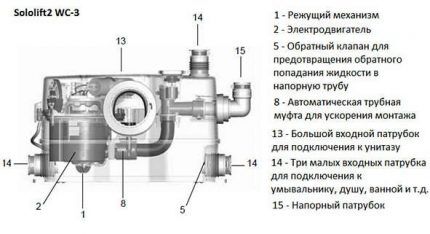
SPS are equipped with pumps of various types, including submersible, surface cantilever or self-priming.
Submersible, as the name implies, lowers a container with sewage into it. Usually these are very durable units that can operate for a long time in an aggressive environment. For such pumps there is no need to arrange a place on the surface, nor are additional pipes needed to connect them to the system.
But maintenance submersible pump may be somewhat difficult. The unit is cooled by the liquid in which it is located; such devices do not often require repairs or maintenance. Moreover, submersible sewage pump models can operate even in very cold environments. For them, the so-called dry installation is considered acceptable.
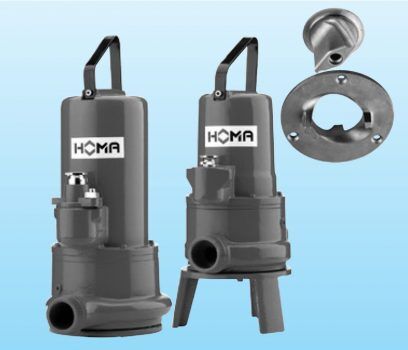
Self-priming pumps have a wide clearance for the passage of the pumped medium; they are recommended for use with significantly contaminated wastewater. A flange-mounted electric motor greatly facilitates the operation and maintenance of devices of this type.
Some types sewage pumps equipped with a special heating element. This allows them to be used even at temperatures below zero.
Cantilever pumps are used mainly for industrial treatment plants. To install such a device, a free-standing foundation is required. Cantilever sewer pumps are considered extremely reliable and convenient, but it is better to entrust their installation and connection to an experienced specialist.
In household pump stations, one or two pumps can be used, it all depends on the specific situation. If it is necessary to grind solid waste fractions, use pumps with a cutting mechanism.
It should be understood that such a mechanism is not an omnivorous meat grinder. A piece of rag accidentally dropped into the drain can lead to serious blockage and even damage to the pump.
The so-called mini pumping stations deserve special attention - these are relatively small pumping stations designed to connect to only one object, usually a toilet. They are a complex of a small storage tank and a pump with a cutting mechanism. Such sewer stations are usually installed directly under the toilet.
Reasons for forced removal of wastewater
Typically, removal of human waste from a sewer system occurs naturally under the influence of gravity. Unfortunately, it is not always possible to practically organize this process at a sufficiently effective level.
Here are a few reasons why a homeowner should consider (or consider) installing a forced drainage system:
- the situation is such that the level of the main sewer drain is located higher than the waste discharge point;
- the waste discharge point is located too far from the main sewer drain;
- wastewater moves through sewer pipes too slowly;
- sewerage often becomes clogged due to errors made during its installation.
Some of these problems may be caused by flaws in the design of the sewer system or its improper redevelopment. But it also happens that, due to the configuration of the building or the topography of the site, the sewer pump station becomes the only choice for the normal operation of the sewer system. Sometimes install KNS It’s simply cheaper than completely redoing the sewer system, eliminating previously made mistakes.
Additional elements for installation of pump station
Sewage stations, like industrial sewerage stations, are equipped with special float sensors placed in a storage tank. They transmit information about the level of sewage in the storage tank to the control unit. The pump turns on and off automatically, which facilitates its operation and extends its service life.
In industrial models, such sensors are installed at four different levels.They reflect the safe state when the storage tank is practically empty, the levels at which the pump should be turned on or off, and the overfill level.
If the last set of float sensors turns on, this indicates a serious breakdown in the system and requires immediate intervention from specialists.
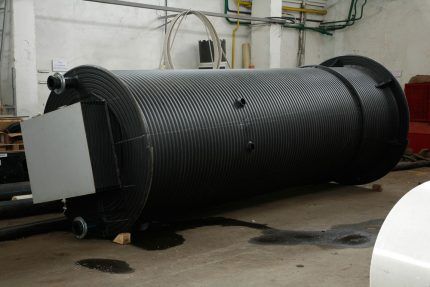
In addition to such sensors, it is also recommended to provide the SNS with a backup power supply and a pressure gauge. Special pressure sensors may be required. An additional set of shut-off valves would not hurt.
The ground part of the KNS is usually hidden under a metal pavilion, but another shelter can be arranged. It must protect the device from bad weather and unwanted outside interference in the operation of the complex mechanisms.
Periodically, both the pump itself and those connected to the pumping station sewer pipes should be cleaned to prevent damage and blockages. It is best to purchase a set of special equipment in advance that will make this task easier. Another important point is the manual control mechanism of the sewage pumping station.
In normal operation it is not needed, since all devices turn on and off automatically. But manual control will be very useful if the pump station breaks down or becomes clogged. When putting a new sewer station into operation, manual control is also used.
Features of installing a sewer station
Installing a pumping station is a labor-intensive and rather complicated task.The KNS tank should be installed at the correct depth. Then the soil is poured around the container and compacted so that its density is as close as possible to the natural density of the surrounding soil.

In general, the installation of a large sewage pumping station can be represented in the following steps:
- Digging a pit.
- Laying a sand cushion.
- Soil compaction.
- Installation of a storage tank in a pit.
- Connection of all pipelines necessary for the operation of the pumping station.
- Installation of a sewage pump.
- Setting up the operation of float sensors.
- Connection of electrical cables, grounding arrangement.
- Backfilling and compaction of soil.
- Installation of protective shelter.
The depth of the pit should be approximately half a meter greater than the height of the storage tank together with the lid. The fact is that the cover of the pump station should protrude above the surface by about one meter, but a sand cushion one and a half meters thick should be laid on the bottom of the pit. When determining the depth of the pit, these parameters should be taken into account.
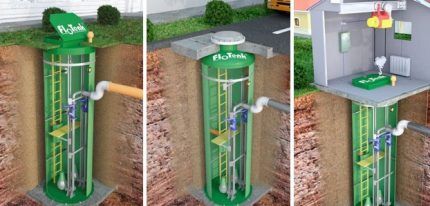
The width of the pit for the pumping station must be such that not only does the tank fit freely there, but there is also room left for the necessary installation work. Of course, there is no point in digging a pit that is too spacious; it is simply unnecessary work.
The pit is usually filled with layers of sand and each layer is compacted so that its density matches the density of the surrounding soil by at least 90%.
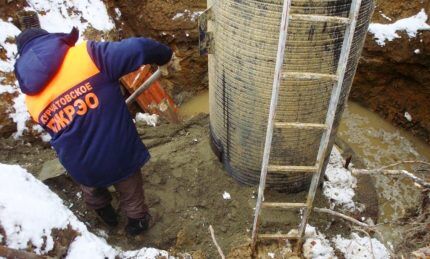
As mentioned earlier, float sensors installed on four levels:
- normal degree of filling is 0.15-0.3 m from the bottom of the container;
- pumping equipment shutdown level - 1.65-1.80 m;
- the level at which the sewage pump turns on is approximately 3.0-3.5 m;
- tank overflow level - 4.5-5.0 m.
After all elements are installed, it is necessary to check the operation of the system.
To do this, you will need a certain amount of ordinary clean water. The liquid can be taken from a water supply or a source of autonomous water supply. If for some reason this is not possible, water is simply brought in a tank.
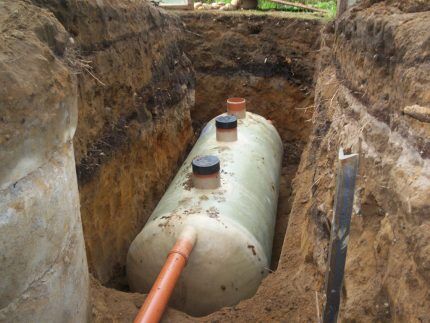
To test, water is supplied to the storage container until it is full, then the water is drained into the sewer. At the same time, they monitor the operation of the float sensors and the functioning of the pumping equipment, which should be turned on and off automatically.
At the same time, check all connections for leaks. If a leak is detected, the connections should be resealed.
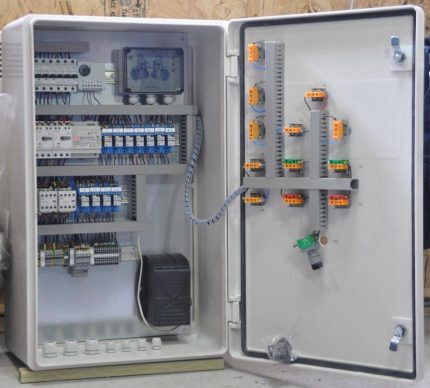
Procedure for servicing the pump station
The operation of any device depends on timely maintenance, and sewer stations are no exception. You should not wait until the breakdown becomes obvious; it is better to carry out preventive inspections in a timely manner.
Such forethought can subsequently result in significant savings, since minor and major repairs differ markedly in price.
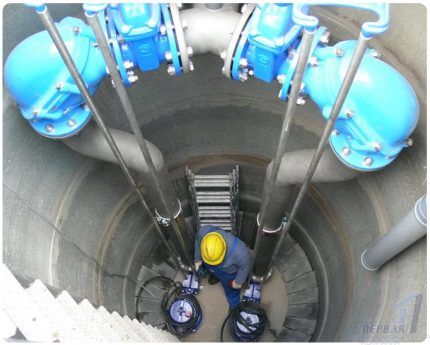
Before starting preventive maintenance work, the sewerage station should be stopped and disconnected from the power supply. Then you need to completely relieve the pressure inside the system, and also wait until the device has completely cooled down. For work you will need work clothes, as well as other protective equipment: a respirator, goggles, gloves, etc.
When servicing domestic sewer pumping stations, it is first recommended to visually inspect the device and check the operation of the shut-off valves. Then the condition of the pumps is assessed.
Problems may be indicated by too high a noise level when operating pumping equipment. Another alarming phenomenon is that the pump vibrates too much during operation. If such dangerous signs exist, the pump can be removed, washed, cleaned, its operation checked and reinstalled in the pump station.
The indicators on the control panel are also assessed. Since solid waste particles can accumulate inside the container in the form of sediment, periodic flushing of not only the pump, but also the storage tank is performed.
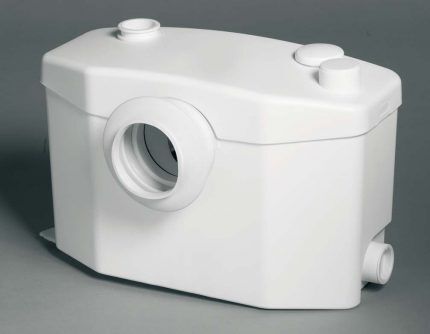
For this, use ordinary water. It can be supplied using a hose. To remove dirt from the inside of the drive, you can use regular household brushes.
But the use of household chemicals in such situations is not recommended. During flushing, care should be taken to ensure that no pressure water comes into contact with the pressure gauge or control panel.
Sewage pumps in such installations are usually mounted on a special pipe coupling. When carrying out preventive cleaning and flushing, it is important to correctly remove the pump from such a coupling, and then ensure that the device is reinstalled correctly.
Another important component is the large debris catcher. It should be inspected and cleaned. During the test, all connections are checked for leaks. All fasteners should be tightened using a wrench.
Features of operation of sewer stations
When choosing a sewerage station suitable for your home, you should remember that different models are designed for different operating conditions. For example, a mini-sump pump designed to connect to a toilet should not be used to remove waste from a kitchen sink or bathroom.
Moreover, if mini-KNS designed to connect to a standard toilet, most likely it cannot be used with a wall-hung toilet model. The proper operation of a sewer pump equipped with a solid waste grinder deserves careful attention.
Some owners believe that if the sewage pumping station has such a function, then any solid waste can be sent to the sewer. This is a dangerous misconception. Of course, if some garbage, for example, personal hygiene products, ends up in the toilet, the shredder will process them without much difficulty.
However, it is not designed to carry this kind of load constantly. The shredder must process mainly fecal waste, which has a completely different density; it cannot be used as a garbage disposal. A large amount of contaminants not intended for this equipment can quickly damage it.
Before purchasing a specific KNS model, you must carefully read its passport and technical characteristics. Particular attention should be paid to the operating conditions of the device, for example, what temperature of the wastewater the system is designed for.
Wastewater from your kitchen sink, bathroom, shower, or automatic washing machine or dishwasher can be quite hot. To prevent the grease from kitchen waste from penetrating the system and creating problematic blockages in it, it is advisable to install grease trap under the sink.
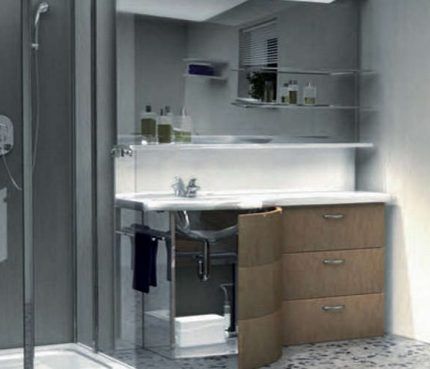
It is necessary to take into account the permissible waste temperature set by the manufacturer for each specific model. Thus, sewage pumping stations, into which warm but not too hot wastewater can be discharged, are suitable for connecting to a shower stall, bathtub, toilet, bidet, kitchen sink, etc.
However, if you have an automatic washing machine, you should choose a home sewer pumping station model that can handle wastewater with a temperature of 90 degrees or higher. It should be borne in mind that the operating mode of such equipment usually involves boiling.
All this also applies to the dishwasher, from which almost boiling liquid can flow into the drain. In addition to your current home needs, you should evaluate your plans to avoid having to purchase and install a new sewer plant.
If you plan to purchase a dishwasher in the future, it is better to immediately choose a water pump designed for drains with high temperatures.
It is worth paying attention to the number and location of pipes. For every new home device that needs to be connected to sewer systemthat may appear in the future, a corresponding pipe must exist. Otherwise, there will simply be nowhere to connect it.
Conclusions and useful video on the topic
An overview of the compact sewage station for the toilet is presented here:
This video schematically depicts the installation process of a large pump station:
A sewerage plant can significantly improve life in your home. It is important to choose the right pump pump model and install it correctly. Proper operation and regular maintenance will ensure that there are no problems with this useful device for many years.
Would you like to talk about installing a sewerage station on your suburban area? Do you have useful information to share with site visitors? Please write comments, ask questions, leave posts with your opinion about the article and thematic photos.




I had the following situation: I built a gym in the basement. I wanted to organize a shower and toilet there, so as not to have to run upstairs. It turned out that this is not such a simple matter, because the level is below the main pipe. I had to pay a considerable amount for my “wants”, I bought KNS, but they are not cheap. Plus, not every plumber understands these devices. In addition, a couple of times a year you need to call a specialist to prevent the system.
I have the same situation, I want to set up a billiard room in the semi-basement and, so as not to be distracted, there is a toilet and washbasin right there.
The foreman insists that this is unrealistic, incorrect and unfeasible; the sewerage system will not drain.
I read it here, I realized that all this is possible, if only you had the desire and skill, there is plenty of equipment for this. I'll probably use the Grundfos pumping station, it seems to be a reliable company.